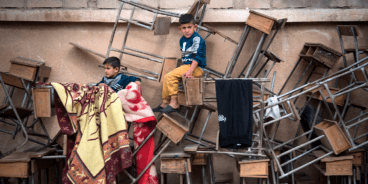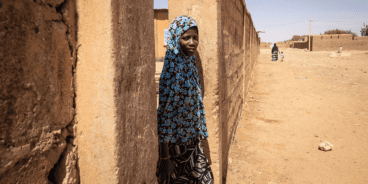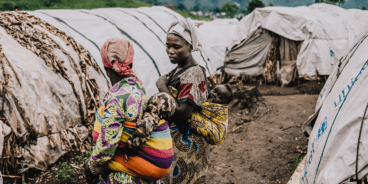
Civil Society Letter to the UN Special Representative of the Secretary General for the Democratic Republic of the Congo, Martin Kobler, on the Lord’s Resistance Army
Dear Mr. Kobler,
As representatives of 59 international and Congolese human rights and civil society organizations, we are writing to you with recommendations on how MONUSCO could better protect civilians and help end violence by the Lord’s Resistance Army (LRA) in northeastern DRC.
For the past 28 years, the LRA has attacked communities in remote parts of central Africa, massacring thousands of civilians and abducting tens of thousands of children into their forces. In northeastern DRC today, many civilians remain traumatized by a series of LRA massacres between December 2008 and December 2009 in which LRA members killed over 1,100 people and abducted over 400 others. While LRA violence has declined in recent years, the group continues to pose a major security threat to civilians living in Haut Uele and Bas Uele districts of DRC’s Orientale Province and senior LRA officers continue to operate there. In 2013, the group committed at least 124 attacks and abducted nearly 200 civilians in DRC. Over 236,000 Congolese civilians remain displaced by LRA attacks, including nearly 18,000 who fled to neighboring countries.
MONUSCO has operated in LRA-affected areas since 2005, but has not provided sufficient protection to civilians living in these areas. While we recognize that MONUSCO has many competing demands across DRC, with dozens of armed groups responsible for attacks on civilians in different areas, we believe much more could be done to better protect civilians in LRA-affected areas without a significant deployment of additional resources. With your leadership and strategic deployment of available resources, MONUSCO could play a key role in ending attacks by one of Africa’s most brutal rebel groups.
Currently, MONUSCO peacekeepers rarely risk direct contact with the LRA, instead seeking to deter LRA attacks through a presence in key towns and periodic patrols along roads.
Attempts to link civilian early warning systems, including a High Frequency (HF) radio alert network, to rapid response patrols by peacekeepers have been mostly ineffective.
Highly mobile LRA fighters easily exploit gaps in the mission’s predictable civilian protection tactics and regularly carry out attacks in close proximity to MONUSCO bases. In August 2010, only 500 meters from a UN peacekeeping base in Duru, the LRA abducted eight civilians, including three children, and later killed three of their captives with machetes. In a two-week span in February 2014, suspected LRA forces committed 10 attacks and abducted 11 people near Nambia, a village just 15km north of the MONUSCO base in Niangara.
There has also been insufficient consultation and sharing of information between MONUSCO and Congolese civil society representatives. Many residents in LRA-affected areas feel frustrated with or indifferent to the mission’s work. MONUSCO personnel are also inconsistent in conducting thorough investigations into reported LRA attacks. As a result, MONUSCO is often left out of local information networks, limiting its ability to analyze trends in LRA activity, understand the threats civilians face, and effectively target its resources to protect civilians.
In addition, the mission’s once robust Disarmament, Demobilization, Repatriation, Rehabilitation, and Reintegration (DDRRR) program has lost momentum in LRA-affected areas. It has failed to gain traction even though recent LRA defectors suggest many fighters are disillusioned and want to defect. Many Congolese community members feel that the DDRRR team does not adequately consult with them when designing programs. The mission has also been slow to react to defection opportunities, including when LRA members indicate their desire to escape. For example, MONUSCO troops rebuffed a Ugandan LRA combatant attempting to surrender to them several times in April and May 2013 before he was finally was able to do so in August of that year.
Below is a set of more detailed recommendations on how MONUSCO could more effectively implement its civilian protection and DDRRR mandates in LRA-affected areas.
We believe that with MONUSCO’s help, it is possible to end violence by the LRA in northeastern DRC. We are encouraged by the tentative but important progress in improving security in other parts of eastern DRC, and we urge you to similarly revitalize the mission’s work in LRA-affected areas.
We would be grateful for the opportunity to meet with you to discuss these recommendations further.
Recommendations on Reinvigorating MONUSCO’s Civilian Protection and DDRRR Efforts in LRA-affected Areas
Reestablish trust and information sharing with the local civilian population
Rebuilding a strong relationship with Congolese civil society leaders and local communities in LRA-affected areas is critical to MONUSCO’s ability to develop, implement, and evaluate effective civilian protection strategies. To facilitate such efforts, MONUSCO should increase the number of Community Liaison Assistants (CLAs) and Military Observers (MILOBS) deployed to MONUSCO bases in these areas and ensure they have an adequate support structure in Dungu.
These personnel, who should include both men and women, should meet with community members more frequently, including via local fora such as open-air community meetings and focus groups. In addition to meeting with local government officials and a small number of civil society focal points, they should consult with a more a diverse range of community members that includes youth, elders, women, religious leaders, and hunters.
Such consultations, which could be enhanced through regular FM radio broadcasts, would also help MONUSCO personnel better explain their activities and mitigate unrealistic expectations within communities. MONUSCO’s community outreach efforts will also improve if its personnel receive enhanced practical training on how to consult with local communities and interact with women and other vulnerable groups.
Support community self-protection initiatives
Facing significant resource constraints across the DRC, MONUSCO peacekeepers alone are not able to consistently protect rural populations in the Ueles from highly mobile LRA groups. However, MONUSCO can significantly improve its support to community self-protection initiatives with low-cost, high-impact activities, such as enhancing information sharing with civilians, improving investigations of LRA activity, and expanding Quick Impact Projects.
Awareness of patterns in LRA movements and attacks can help civilians reduce their vulnerability to the rebel group. MONUSCO personnel, particularly civilian staff and MILOBs, should use meetings of local security committees in towns where they are deployed to widely disseminate information about trends in LRA activity. MONUSCO personnel should also more proactively share information with civil society in the more remote communities surrounding their bases and explore ways to enhance information sharing with unarmed civilian self-defense groups.
By engaging in such initiatives, MONUSCO personnel may find community members, such as hunters, more willing to share information about LRA attacks, travel routes, and camps. As part of a mutual exchange of information, MONUSCO personnel in the field should be encouraged to conduct thorough investigations of LRA attacks, including via direct interviews with victims of LRA attacks and LRA escapees whenever possible. This information can then be analyzed together with information the mission collects in other communities, allowing MONUSCO to then provide civilians with new insights on LRA activity trends that can inform and enhance self-protection strategies.
In consultation with humanitarian organizations, MONUSCO should expand the use of Quick Impact Project (QIP) funds. QIP funds can support trainings and workshops in which community members can reinforce practical strategies to minimize their vulnerability to LRA attacks when farming, hunting, and traveling along roads. QIP funds can also be used to improve local infrastructure that reduces civilian vulnerability to LRA attacks, for instance by placing water pumps in more secure areas. MONUSCO personnel should ensure such projects take particular account of the vulnerability of women and children and do not place civilians at greater risk by undermining existing self-protection strategies.
Ensure protection measures are tailored and coordinated
Improved information sharing with Congolese communities will help the battalion of Moroccan peacekeepers (MORBAT) deployed in LRA-affected areas execute their civilian protection responsibilities more effectively. In particular, community input can help ensure the MORBAT tailors their patrols to best minimize local threats to civilians, including by conducting foot and vehicle patrols along specific roads and near villagers’ farms. Together with more mobile peacekeeping units, such as the Guatemalan Special Forces (GUASFOR), the MORBAT should also respond more quickly when LRA forces repeatedly threaten civilians in outlying towns, as they did in Nambia in February 2014.
MONUSCO leadership should also improve its coordination with the Congolese security forces, especially those deployed with the AU Regional Taskforce on the LRA (RTF), and with US military advisers in Dungu. The Joint Intelligence Operations Centre (JIOC), which analyzes trends in LRA activity and coordinates all military forces deployed in the Ueles, could play a greater role in planning peacekeeper patrols and deployments. Patrols are currently designed largely by MONUSCO Ituri Brigade personnel in Bunia who are located far away from LRA-affected areas and are not as familiar with LRA activity, RTF operations, and civilian vulnerabilities. The JIOC can play an especially important role in two regards: guiding MONUSCO patrols to ensure they mitigate risks to civilians during RTF counter-LRA operations and providing MONUSCO personnel in outlying towns with strategic information gathering objectives.
Congolese communities have also expressed a strong desire for MONUSCO peacekeepers to enhance their support to Congolese army troops tasked with protecting civilians in LRA-affected areas, including through increased logistical support and joint patrols. If they do so, the mission should ensure that these troops are properly screened, according to the guidelines in the UN’s Due Diligence Policy, and that peacekeepers do not provide support to Congolese army units that have been responsible for serious human rights abuses.
Revitalize DDRRR
DDRRR is an effective and resource-efficient method of reducing the LRA’s capacity to attack civilians. MONUSCO should increase the funding and personnel available to the Dungu DDRRR office, which should deploy civilian staff attached to each forward MONUSCO deployment. DDRRR personnel, particularly those deployed to the field, should more frequently consult community members on DDRRR activities, including leaflets and FM radio sensitization campaigns. They should gather information from community members about the movements and activities of LRA groups, and develop rapid response strategies when LRA defection opportunities arise. MONUSCO personnel should ensure that community members are not only consulted, but have influence on the implementation of such initiatives.
DDRRR personnel should better coordinate their work with defection initiatives led by NGOs and the US State Department and military advisers. They should also improve training for MONUSCO peacekeepers on how to recognize signs that LRA members are trying to escape, facilitate their surrender, and coordinate with DDRRR personnel to ensure that peacekeeping patrols do not inadvertently undermine DDRRR initiatives.
In consultation with UN civilian agencies and humanitarian groups, MONUSCO’s DDRRR team should also provide technical and material support to reintegrate Congolese civilians defecting from the LRA. MONUSCO personnel can help design reintegration projects that actively involve host communities, promote economic and social interdependence, and reduce communities’ hostile attitudes towards former LRA.
Signatories:
Africa
- Action Humanitaire Justice pour Victime
- Action pour le Développement et la Protection Communautaire (ADPC)
- Association de Taxi Moto Dungu (ATAMOD)
- Association des agriculteurs de Bangadi
- Association des Femmes des Nazawa pour le Développement (AFND)
- Associations des Mamans de Bangadi
- Associations des Mamans de Duru
- Association des Mamans de Ngilima
- Association Nationale des Mamans pour l’Aide aux Déshérités (ANAMAD)
- Carrefour juridique culturel
- Centre de Réinsertion et d’Accompagnement au Développement (CRAD)
- Coalition Congolaise pour la Justice Transitionnelle (CCJT)
- Coalition Nationale pour la CPI en RDC
- Collectif des Auxiliaires Libéraux de Justice
- Commission Autochtone de Lutte contre la LRA: CALL
- Commission Diocésaine de Justice et Paix du Dioèce d’Isiro Niangara
- Commission Diocésaine de Justice et Paix du Diocèse Dungu Doruma
- Commission Diocècaine de Justice, Paix et Réconciliation, Diocèce Anglicanne d’Aru
- Congo Action pour le Développement (CAD)
- Communauté pour la Promotion des Humains (CPH)
- Communicateurs pour la Promotion, Protection et Défense des Droits de L’homme plus
la Ligue des Femmes Défenseures de droits Humains ont leurs sièges au Kasai Oriental
(COPPRODDHO ONGDH ) - Congo en Images (CIM)
- Dynamique de Développement Durable (DDD)
- Fondation Congolaise pour la Promotion des Droits de l’Homme et la Paix
- Fondation point de vue des jeunes africains pour le développement (FPJAD asbl)
- Forum des Mamans de l’Ituri (FOMI)
- Groupe d’Associations de Défense des Droits de l’Homme et de la Paix (GADHOP)
- Groupe LOTUS
- Initiative Congolaise pour la Justice et la Paix (ICJP)
- Institut Supérieur de Dungu (ISD)
- JUSTICIA Asbl
- la Ligue des femmes défenseures des Droits Humains (LIFEDDH)
- Ligue des volontaires pour la défense des droits humains (LISVDHE)
- Ligue Nationale Pour Les Elections Libres et Transparentes (LINELIT)
- Ligue pour la Promotion et le Développement Intégral de la Femme et de l’Enfant
- Mama Tiya Molende (MTM)
- ONGDH Justice Plus
- Option pour Assister les Personnes Vulnérables (OAPV)
- Président de la société civile Bangadi
- Président de la société civile de Faradje
- Protection, Action pour le Développement Intégrale (PADI)
- Réseau des associations des droits de l’homme du Sud Kivu (RADHOSKI)
- Réseau des Organisations féminines des Uélés (ROFU) [15 organisations féminines]
- Rt. Rev. Samuel Enosa Peni, Bishop of the Diocese of Nzara, South Sudan and Chair for
Regional Taskforce for Religious Leaders and Civil Society in the LRA-affected region - Société Civile de Niangara
- Solidarité des Volontaires pour l’Humanité (SVH)
- Solidarité Féminine pour la Paix et le Développement Intégral (SOFEPADI)
- Solidarité et Assistance Intégrale aux Personnes Démunies (SAIPED)
- Terre des enfants
- Youth Program for the Development of Africa (YPDA)
North American/Europe
- Conciliation Resources
- Discover the Journey
- The Enough Project
- European Network for Central Africa (EurAc)
- Global Centre for the Responsibility to Protect
- Jocelyn Kelly, Director, Women in War Program, Harvard Humanitarian Initiative
- PAX
- The Resolve LRA Crisis Initiative
- The Roméo Dallaire Child Soldiers Initiative
Related Content


